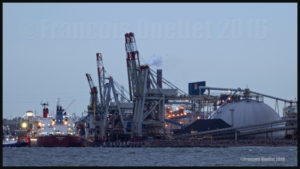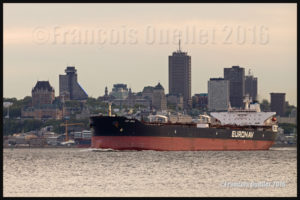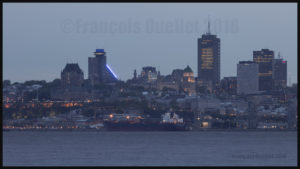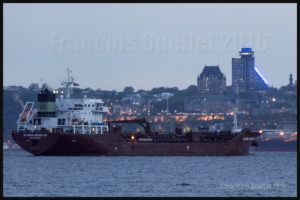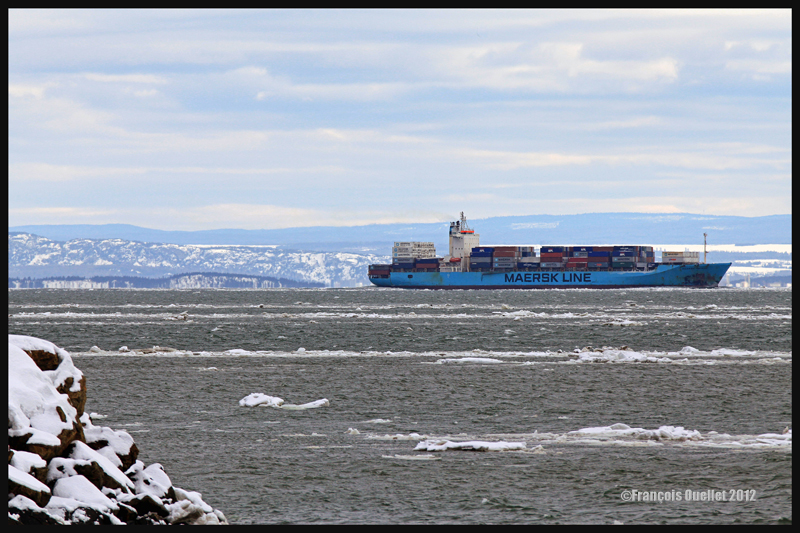Here are a few recent photos taken during the month of May 2016 using a Canon 5DSR camera equipped with a Canon 70-200 f2.8L IS II USM telephoto lens. I was on île d’Orléans for the photo session, near the Horatio Walker promenade in Sainte-Pétronille.
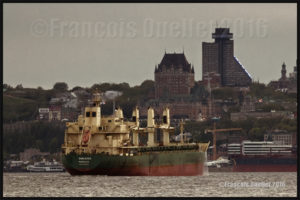
The picture above shows the vessel Shelduck flying the Liberian flag. It just crossed the narrow channel between île d’Orléans and Levis. This ship, built in 2012, is a bulk carrier. In the background it is possible to see Quebec City, with the Château Frontenac and the Hotel Le Concorde Quebec.
The photo below shows the Silver Carla (Majuro), a tanker used to carry oil and chemical products. It is moored at the Quebec harbour installations. The ship was built in 2014 and sails using the Marshall Islands flag of convenience.
In the picture below, the tanker Cap Jean, property of Euronav, is approaching île d’Orléans. This tanker was initially supposed to be named St. Jean but the name’s religious connotation could have caused problems in some parts of world. The name Cap Jean was thus chosen.
The photo below, also taken from île d’Orléans, offers an interesting view of Quebec City just before nightime. The Hotel Le Concorde Quebec’s new lighting system is visible in the distance. In the foreground, you can see the ship Laurentia Desgagnés.
Below, the ship Nilufer Sultan is heading towards Quebec harbour. Built in 2008, this oil tanker also uses the Marshall Islands flag of convenience.
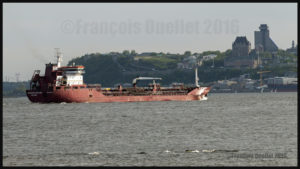
The photo below shows the tanker Sloman Herakles, normally based in St. John’s, Canada. It sails under the Antigua and Barbuda flag and is heading to Sarnia, Ontario.
The two photos below show the container ship Toronto Express, property of the Hapag Lloyd Company. I chose to transform the first picture in black and white since the ship did not contrast enough with the background in the colored picture. It is actually slightly inclined since it is turning towards the right while approaching île d’Orléans. On the next picture, we can see in the background the smoking chimney of the Papiers White Birch Company, formerly called Daïshowa and later Stadacona.
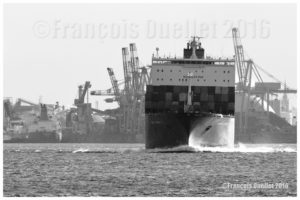
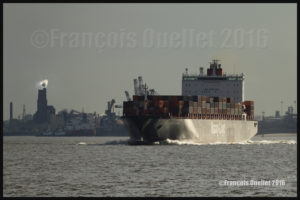
Below is the chemical tanker Mayaro (Japan) arriving near Quebec City in May 2016.
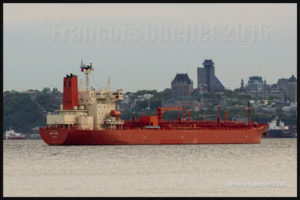
Taking pictures in the evening
Trying to take pictures of moving ships in the evening, using the smallest possible ISO, forces a photographer to use a tripod, a remote trigger and the camera’s mirror lock-up function to reduce vibrations. Ideally, it is best to find a spot where the tripod will be protected from the wind while ensuring that the camera’s strap is not moving at all. There is no need to use a polarizing filter at this time of the day: that would only be detrimental to the photo.
The Canon 5DSR DSLR full frame camera allows the photographer to take a picture in two steps, reducing even more the possibility of secondary vibrations. First, the mirror is lifted up. Then, two seconds later, the photo is finally taken. For a sharper image, it is best to use the Liveview function with a 16X enlargement and do a manual focus adjustment.
Risks associated with photography!
On île d’Orléans, many visitors use the surroundings banks to let their dog roam freely. This can cause a problem as the animal sometimes perceives the photographer and his photographic equipment as a potential threat to a master that it must protect… You will have been advised!
For other ship photos posted on my website, click on the following link:
For other photos on the province of Quebec and also Quebec City, click on the following links from my blog:
